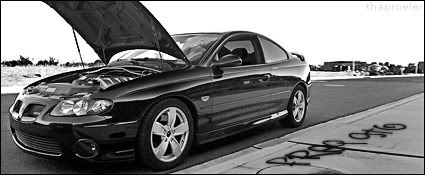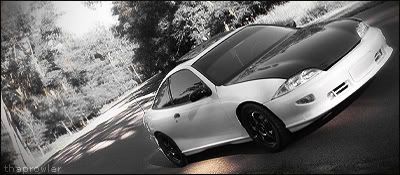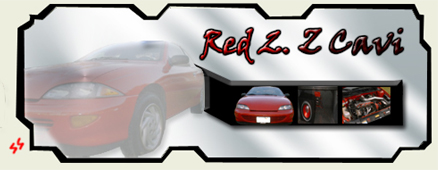So I've read most of the posts on the black Pacesetter headers...so i know the paint will come off.
My question is, does that make it perform any worse than the armour coated one? i realize there may be a slight temperature difference with the different finishes, but is there a paint i can buy after and re-finish the black ones?
Respect...
It wont make any performance difference, but it will make a life difference. The painted one will rust apart, but the ceramic one will probably outlast your car,
steve white wrote:It wont make any performance difference, but it will make a life difference. The painted one will rust apart, but the ceramic one will probably outlast your car,
not true. the ceramic coating aids in keeping the heat inside the header, which keeps the exhaust gases expanding, which helps in the scavenging affect, pulling the exhaust out of the head. it helps pull more fresh air in from the intake side.
granted, you won't see a 20 hp gain with going to the coated header, but it does help.
Desert Tuners

“When you come across a big kettle of crazy, it’s best not to stir it.”
what about hte header wrap over instead of the painted header? would it do something similar?

Brad wrote:what about hte header wrap over instead of the painted header? would it do something similar?
the header is more prone to rusting with header wrap. it'll work better than uncoated, but if it gets wet, and the water isn't completely evaporated out of the wrap, the wrap just keeps the moisture right on the metal.
Desert Tuners

“When you come across a big kettle of crazy, it’s best not to stir it.”
Just buy a coated header it will last longer.
whats the point of going cheap and having to replace the header again in a few years.

I got hte painted one for free, so I don't honestly care. the VHT extreme heat paint, any chance of using it with the header wrap? it would create a barrier from moisture. I'm considering attempting this, any thoughts?

If you got the painted one for free, then even if you send it out to HPC or anyone else for a ceramic coating you'll still be ahead. The headers for the J-cars (Or any other model chassis that uses the same engine) aren't cheap in comparison to those for, say... a small-block Chevy. Cerami-coating just makes sense for the cost of the investment, and since you got it for such a good deal on yours I'm sure that, just like anyone else, you'd like it to last.
Go beyond the "bolt-on".
if you want to save some money go ahead and get the high heat header paint and bake it on, read the directions.
THEN wrap it with the heat tape. should be just as good as ceramic coating in terms the heat transfer etc but probably wont last as long still.
just know... most if not all ceramic coatings dull out so they dont look as good as they do when they are first coated BUT the coating always stays, just loses the luster.

Fall 08 Omaha/western Iowa area meet...
CLICK ME!
z yaaaa wrote:if you want to save some money go ahead and get the high heat header paint and bake it on, read the directions.
THEN wrap it with the heat tape. should be just as good as ceramic coating in terms the heat transfer etc but probably wont last as long still.
just know... most if not all ceramic coatings dull out so they dont look as good as they do when they are first coated BUT the coating always stays, just loses the luster.
FO SHO, my LSJ coating has seen better days, but is still there and still works...

8 years on my Pacesetter Ceramic coated header. Little to no rust at all and it still looks great.
Misnblu.com
Newbie member since 1999
Thank you Dave and JBO! 

I can almost guarantee no dyno will show a difference between coated and uncoated, but like everyone sales uncoated will rust. The tag on new PS uncoated headers even instructs you to strip the paint off and coat it. Dupli Color makes high heat, ceramic based, header coating. Local VatoZone has it on the shelf.

FstCavZ24 wrote:Local VatoZone
HAHAAHAHAAHAAHAHAHAAHA


Fall 08 Omaha/western Iowa area meet...
CLICK ME!
FstCavZ24 wrote:I can almost guarantee no dyno will show a difference between coated and uncoated, but like everyone sales uncoated will rust. The tag on new PS uncoated headers even instructs you to strip the paint off and coat it. Dupli Color makes high heat, ceramic based, header coating. Local VatoZone has it on the shelf.
they have the same stuff out here, maybe I'll give it a try.

DO NOT WRAP YOUR HEADER !
If you have the painted one, go to a shop that coats headers. I had the Pacesetter header that was coated, still looks good. Now i have a custom mild steel ones, i painted them just so they would last the season, this winter 4 - O2 bongs are getting welded to it and then getting coated, doesnt matter how much it costs
Thats my 2 cents
-Ben
header wrap is the worst thing you could do to a pipe.
it seals in moisture, and it doesn't let the metal breathe properly and contributes to greater heat fatigue of the part.
stahlheaders wrote:Should I use a Header Wrap?
NO! ABSOLUTELY NOT. There is nothing that will damage a header faster than the use of a header wrap, other than attacking it with a hammer or shot gun. As advertised, these wraps do keep the majority of exhaust gas temperatures within the header. The result is the wraps will prohibit the header tubing from cooling properly. If you reduce the ability for headers to dissipate adequate heat properly, the result will be premature failure of the metal. Depending upon the application use and temperatures involved, the life can be reduced to only a few hours. We consider exhaust wraps to be the header manufacturer's best friend.
If engine compartment temperatures are an issue, the best solution is to use insulation materials on the sheet metal. One alternative in some applications is to build a box around the headers and actually duct outside air into the box. In some applications ceramic coatings have been known to help (see notes on coatings above). Insulating any components that may be sensitive to heat, such as wiring, fuel & oil lines, etc., are a better option.
350z forum wrote:
I have heard this question tossed around a few sports car enthusiast websites and decided to do a bit of research on the issue. This deals with the use of heat wrap around the headers vs. having them coated.
Facts: - Heat wrap is used to keep the heat inside of the header and improve scavenging of exhaust gasses. This helps to keep the heat inside of the header and allow for an even, high rate of exhaust gasses.
- Manufacturers of headers will not warranty their products (to include factory warranty) if the header itself is wrapped.
- Header wrap will damage the header beyond repair, no matter what material it is made of.
- When running a lean mixture, you "may" see minimal, if any gains at all. If you are running rich, you will not gain anything at all.
- And most importantly, if you do not mind replacing your headers and gaskets on a regular basis, and love the look of headers wrapped with tape (ugh), then this mod is for you.
Background on header/exhaust wrap. The use of header wrap started on the race circuit, mostly NASCAR, to improve on power gains. After time they figured that changing the headers and that after each race was not cost productive for such a minimal gain, the practice was done away with. Now, they use chemically treated or electrical applied treated headers. These include Jethot, Airborn, and others.
Just imagine for the average street car owner/enthusiast, having to replace a set of $700 to $1200 headers each week. You would not have any money to do any other modifications that would be of more benefit.
Proper use of heat wrap would be to use this for protecting fuel and oil lines. Most cars have adequate firewalls to protect the driver from the engine heat so using that as an excuse for wrapping is incorrect.
Headers need to be surrounded by cool air to function properly. When you use wrap you basically are trapping the heat in, and temperatures can almost reach the melting point. You have seen videos of cars on a dyno. Notice how hot the headers get? I saw one where they glowed bright red. Imagine that wrapped up, what would happen to them. I read that some designers and engineers say that the material used for the headers are designed to withstand those high temperatures. This may be true. But when the header is not allowed to cool properly this leads to nothing but failure of the part. It is simple thermal isolation. The headers get the heat source from the engine. The heat on the outside of the header is basically trapped between the wrap and the header, causing a layer of extreme heat to have no where to go except back into the header material itself. Over time, this is amplified and can fatigue the header. Another thing to realize that is over time, headers oxidize, losing some material in the process. This leads to lighter and weaker headers. When wrapped this basically speeds up the process.
What works. On a test track circuit with 10 laps using Jet Hot coated and uncoated headers, the Jet Coat headers actually lowered the temperature measured 1" from the header by over 450 degrees.
Jet Coat and other companies use a process which actually becomes part of the material of the header. Example. the header is allowed to cool normally because there is no thermal barrier trapping the heat in (header wrap) but the coating acts like the thermal wrap in that it helps to reduce the amount of heat into the engine bay. Weird huh? Not really. Plus the corrosion of the headers are reduced, and because the heat is not stressing the metal they last longer. This process is permanent, meaning that it actually becomes part of the header itself.
In Closing, I have explained that manufacturers will not warranty headers if they have been wrapped. Just because a product performs the way it is advertised, it doesn't make it the right thing to do. This is the case with heat wrap. You would be best off protecting the fuel and oil lines with it instead. If you want a true thermal barrier that allows for normal cooling plus protection from heat, have your headers treated inside and out for the best quality protection. Just remember that this is a permanent process, and once done it cannot be undone. And be sure that having the headers coated should be the last thing you do to them, ater ensuring adequate it and any small modifications are done to them. This will save you money in the long run.

Thanks for all the info, I'm definatley going to buy the armour coated ones.
sorry for bringing this from the beyond but I have a ?
I remember this conversation going on back in the spring and someone found something called header socks. They went over the header but weren't tight. So it seemed to allow for the header to breathe as well as keep temps in and the temp in the engine bay down.
Anybody remember this I am thinking of trying it out.
The proper way of using the word seen. It is not I seen it that would be I saw it. He has seen the car is the right way to use the word. English class is Cool. By the way thats my sig
Don't... Not if you value the life of your header. All those wraps do is wick moisture from the air into them, and it gets held against the header tubes causing it to rust like as if it was sumerged in salt water. (Re: Premature) And if you drive through a puddle, or with that stufff on in winter, get ready to say good-bye to your costly header (The do cost alot, don't they?) sooner. The ceramic coating is an option best taken if available, trust me.
Go beyond the "bolt-on".
Do it right or don't do it.
Especially in this particular case, doing it the cheap way is worse than if you just left it alone.

ive had the pacesetter 4-1 coated one 3 years. no problems.

"There is no point in looking fast if your not."













